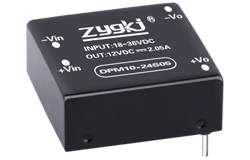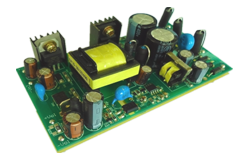nouvelles
Design and Analysis of a Bidirectional DC-DC Converter for Power Electronics Applications
Auteur: Module d'alimentation ZYG Time: 2023-6-19
Introduction:
Power electronics has become an integral part of many electrical systems. It is used to manage power, convert power from one form to another, and distribute power. One of the most commonly used power electronics devices is the DC-DC converter. A DC-DC converter is an electronic circuit that converts a DC voltage level from one level to another. In this paper, we will discuss the design and analysis of a bidirectional DC-DC converter that can be used in power electronics applications.
Design:
The bidirectional DC-DC converter consists of two parts: a buck converter and a boost converter. The buck converter is used to step down the input voltage, and the boost converter is used to step up the output voltage. The input voltage can be either positive or negative, and the output voltage can also be either positive or negative.
To design the bidirectional DC-DC converter, the first step is to determine the specifications of the converter. The input voltage range should be between -30V to +30V, and the output voltage range should be between -15V to +15V. The output current should be 2A, and the switching frequency should be 20kHz.
The next step is to select the components for the converter. The components used in the buck converter are an inductor, a MOSFET, a diode, and a capacitor. The components used in the boost converter are an inductor, a MOSFET, a diode, and a capacitor. The inductors and capacitors are selected based on the current and voltage requirements. The MOSFETs and diodes are selected based on their current and voltage ratings.
The third step is to calculate the values of the components. The inductor values are calculated using the following formula:
L = (Vin – Vout) x Ton / (Vout x Iout x fs)
where L is the inductance, Vin is the input voltage, Vout is the output voltage, Ton is the on-time of the MOSFET, Iout is the output current, and fs is the switching frequency.
The capacitor values are calculated using the following formula:
C = Iout x Ton / (ΔV x fs x Vout)
where C is the capacitance, Iout is the output current, Ton is the on-time of the MOSFET, ΔV is the ripple voltage, fs is the switching frequency, and Vout is the output voltage.
The fourth step is to simulate the circuit using a simulation tool such as LTspice. The simulation is used to verify the circuit design and to optimize the component values. The simulation results are used to modify the component values if necessary.

Analysis:
The bidirectional DC-DC converter is analyzed based on its efficiency, voltage regulation, and transient response. The efficiency of the converter is calculated using the following formula:
Efficiency = Pout / Pin
where Pout is the output power and Pin is the input power.
The voltage regulation of the converter is analyzed by measuring the output voltage under different load conditions. The voltage should remain within the specified range under all load conditions.
The transient response of the converter is analyzed by measuring the output voltage under sudden changes in load or input voltage. The output voltage should respond quickly to changes in load or input voltage.
Conclusion:
The bidirectional DC-DC converter is a useful device for power electronics applications. It can be used to step up or step down the voltage and can be used in both positive and negative voltage applications. The design and analysis of the converter require careful consideration of the component values and the simulation results. The efficiency, voltage regulation, and transient response of the converter are key factors in its performance. The bidirectional DC-DC converter can be used in various applications such as battery charging, renewable energy systems, and electric vehicles.
Précédent: Medical Power Series: Empowering Healthcare Professionals with Knowledge and Skills
Prochain: SM Series AC DC Power Supply
les informations pertinentes
-
2023-7-14
Introducing the SPM Series: AC DC Converter for Optimal Power Conversion
In today's fast-paced world, where technology rules and energy efficiency is paramount, finding the right power conversion solution is crucial. That is why we are excited to introduce our latest innovation, the SPM Series AC DC Converter. Designed to provide optimal power conversion, the SPM Series is set to revolutionize the industry. The SPM Series AC DC Converter boasts state-of-the-art technology that ensures efficient and reliable power conversion. Whether you are operating in a commercial, industrial, or residential environment, this converter is the ideal solution for all your power conversion needs. One of the key features of the SPM Series is its ability to convert alternating current (AC) to direct current (DC) efficiently. This conversion is essential for many electronic...
Voir les détails -
2023-5-20
Efficient AC to DC Converter for 24V Power Supply
Introduction In today's world, the demand for efficient AC to DC converters is increasing at a rapid pace. This is because most modern electronic devices require a DC power supply to function properly. However, the power supplied to our homes and offices is in the form of AC power. Therefore, an efficient AC to DC converter is required to convert the AC power to DC power. In this article, we will discuss an efficient AC to DC converter for a 24V power supply. Background The main function of an AC to DC converter is to convert the AC power to DC power using various electronic components such as diodes, capacitors, and transformers. The efficiency of the converter depends on the...
Voir les détails -
2023-5-19
Efficient AC to DC Conversion with the 12V Converter Module
Efficient AC to DC conversion is essential for electronic devices that require stable and consistent power supply. The easiest and most traditional way to convert the power is by using a transformer. This type of conversion produces excellent results, but it is not always the most efficient process. In recent times, the use of 12V converter modules has grown increasingly popular due to their efficiency in AC to DC conversion. In this article, we will be discussing some of the advantages of using the 12V converter module. Compact size One of the most significant advantages of the 12v converter module is its compact size. It is much smaller than the bulkier transformer, which means it takes up comparatively less space,...
Voir les détails -
2023-6-28
The Electrifying Power Series: Exploring the Wonders of Electricity
Electricity is one of the most incredible wonders of modern science. It has revolutionized the way we live and has brought about significant changes in almost every aspect of human life. From powering our homes and industries to facilitating communication and transportation, electricity has truly electrified our lives. In this article, we will explore the electrifying power series and discover the wonders of electricity. The Power of Electricity Electricity is a form of energy that is created by the movement of electrons. It is generated from a variety of sources, including fossil fuels, nuclear power, and renewable sources such as solar and wind. Once generated, electricity is transmitted through power lines to homes, businesses, and industries, where it is used...
Voir les détails -
2023-5-12
How to convert AC to DC power 12V?
Introduction Alternating current (AC) is a type of electrical current that flows back and forth in a circuit. Direct current (DC), on the other hand, flows in a single direction. While many household appliances and electronics run on DC, the power that comes out of a wall socket is AC. Therefore, to use these appliances and electronics, you need to convert AC to DC power. In this article, we will explain how to convert AC to DC power, specifically 12V DC. We will discuss the different types of AC to DC converters, step-by-step instructions on how to convert AC to DC power, and some safety tips to keep in mind while doing so. Types of AC to DC Converters There...
Voir les détails -
2023-5-4
AC-DC Power Supply: The Ultimate Solution for Reliable Energy Conversion
AC-DC power supply is a type of power supply that converts AC (alternating current) power from the mains into DC (direct current) power that can be used by electronic devices. It is an essential component in most electronic devices, ranging from household appliances to medical equipment. One of the main advantages of an AC-DC power supply is its reliability. It is designed to provide a stable and consistent output voltage, which is essential for the proper functioning of electronic devices. This makes it a popular choice for critical applications where power interruptions can result in significant consequences, such as in medical equipment or industrial control systems. Another advantage of an AC-DC power supply is its efficiency. It is designed to...
Voir les détails


















